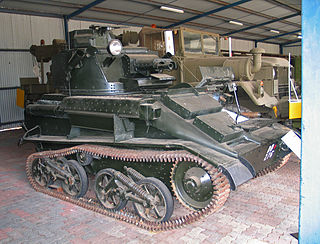 W
WThe Light Tank Mark I to Mark V were a series of related designs of light tank produced by Vickers for the British Army during the interwar period.
 W
WThe FV101 Scorpion is a British armoured reconnaissance vehicle. It was the lead vehicle and the fire support type in the Combat Vehicle Reconnaissance (Tracked), CVR(T), family of seven armoured vehicles. Manufactured by Alvis, it was introduced into service with the British Army in 1973 and was withdrawn in 1994. More than 3,000 were produced and used as a reconnaissance vehicle or a light tank. It holds the Guinness world record for the fastest production tank; recorded doing 82.23 km/h (51.10 mph) at the QinetiQ vehicle test track, Chertsey, Surrey, on 26 January 2002.
 W
WThe FV300 series was a project for a series of lightweight armoured fighting vehicles by the United Kingdom between 1947–50, a few years after World War II.
 W
WThe Light Tank Mark I to Mark V were a series of related designs of light tank produced by Vickers for the British Army during the interwar period.
 W
WThe Light Tank Mark I to Mark V were a series of related designs of light tank produced by Vickers for the British Army during the interwar period.
 W
WThe Light Tank Mark I to Mark V were a series of related designs of light tank produced by Vickers for the British Army during the interwar period.
 W
WThe Tank, Light, Mk VI was a British light tank, produced by Vickers-Armstrongs in the late 1930s, which saw service during the Second World War.
 W
WThe Light Tank Mk VII (A17), also known as the Tetrarch, was a British light tank produced by Vickers-Armstrongs in the late 1930s and used during the Second World War. The Tetrarch was the latest in the line of light tanks built by the company for the British Army. It improved upon its predecessor, the Light Tank Mk VIC, by introducing the extra firepower of a 2-pounder gun. The War Office ordered 70 tanks, an order that eventually increased to 220. Production was delayed by several factors and only 100 to 177 of the tanks were produced.
 W
WThe Tank, Light, Mk VIII (A25), also known as the Harry Hopkins, after American President Roosevelt's chief diplomatic advisor, was a British light tank produced by Vickers-Armstrong during the Second World War. The Mk VIII was the last in the line of light tanks the company had built for the British Army, and was intended to be the successor of the previous light tank designed by Vickers-Armstrong, the Mk VII Tetrarch. A number of changes were made to the Mk VIII, most notably increasing its width, length and weight and also increasing the thickness of the armour. The design of the tank was submitted to the War Office in late 1941, with an initial order for 1,000 models being made by the Tank Board of the War Office in the same month, a number that increased to 2,410 in November. Production began in June 1942 but immediately began encountering problems with the tank, and a number of modifications had to be made to the design after complaints were made by the War Office and the Fighting Vehicle Proving Establishment. These problems were so acute that only 6 tanks had been produced by mid-1943, and only 100 when production ended in February 1945.
 W
WSabre is a variation of the Combat Vehicle Reconnaissance (Tracked), featuring the turret from a wheeled Fox Armoured Reconnaissance Vehicle mounted on the hull of a tracked FV101 Scorpion.